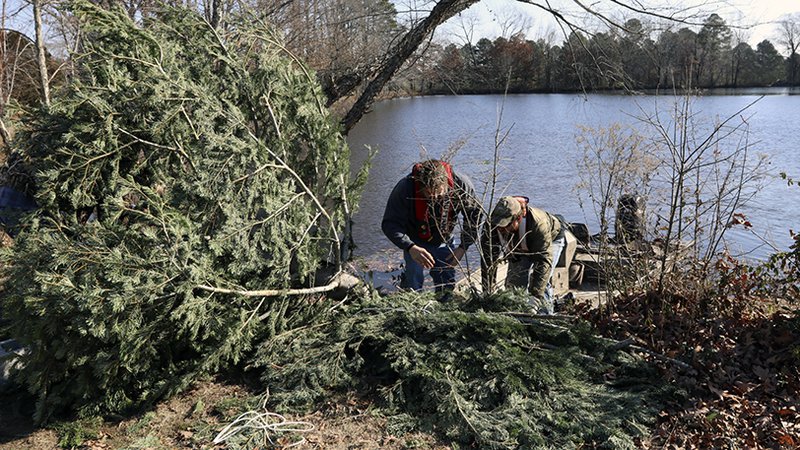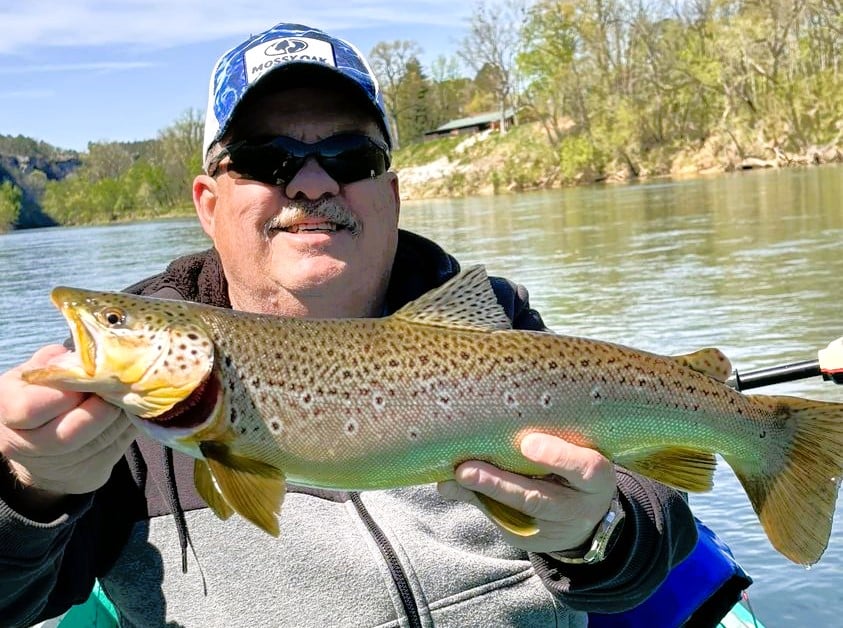Downtown Little Rock Christmas Tree provides year-round enjoyment
ON 01-10-2018

Jan. 10, 2018
Randy Zellers
Assistant Chief of Communications
Little Rock’s Christmas tree, which spent the holiday season wowing visitors on Capitol Avenue and Main Street, borrowed a page from New York City’s tree this year, with a small twist. Rockefeller Plaza trees historically have been used as lumber for Habitat for Humanity homes. Little Rock’s tree also was used for habitat, but it will stay true to The Natural State’s motto. The habitat it creates will benefit one of Little Rock’s family fishing destinations.
The tree, a 40-foot white fir, was cut into sections and placed in Western Hills Lake in Southwest Little Rock Saturday, Jan. 6. Thanks to the Downtown Little Rock Partnership, Arkansas Game and Fish Commission staff were able to collect the large sections of brush and transport them to where they will offer enjoyment to many anglers over the next few years.
Western Hills Lake is part of the AGFC’s Family and Community Fishing Program, which stocks eating-sized trout and catfish in cities to make it easier for every Arkansan to wet a line and bring home a healthy supper.
“The lake is beautiful and deep, and I really see us doing some amazing things in our partnership with the owners of the area,” said Clint Coleman, assistant coordinator of the program. “This Christmas tree habitat is a great way to get the ball rolling on habitat, and it’s a great way to give this tree one more chance to add to the habitat of a natural system.”
The state capitol tree isn’t the only opportunity to increase habitat from Christmas leftovers. Each year the AGFC designates special drop off locations throughout the state, where people can leave their trees so they may be used as fish attractors.
“We will sink these trees in nearby lakes as time allows toward the end of January, but until then, we really want anglers to be able to use them to make their own fishing hot spots,” said Coleman, “I’ve seen a lot of good trees at some of the drop off locations that would make a great crappie mat or brush pile for bass.”
Coleman says all it takes to create a hot spot out of these trees is some rope and something to weigh them down.
“Parachute cord and cinder blocks are good choices that will get the job done cheaply,” Coleman said. “If you can, it’s best to sink at least 5 or 6 trees at a spot, so the pile continues to attract fish for a few years.”
Anglers should contact the owner of the lake or reservoir where they wish to create their own fish attractors to ensure they are legal. Some water-supply reservoirs do not allow the placement of natural cover, and the U.S. Corps of Engineers asks that people call ahead to ensure the cover will not interfere with the operation of their reservoirs.
“We encourage anyone who wants to sink a tree in an AGFC lake to call the district office over that lake as well,” Coleman said. “The regional biologist may have some good suggestions on places to sink the brush or ways to help out.”
Some AGFC lakes that would benefit greatly from the increased habitat are lakes Elmdale, Bob Kidd, Charles, Frierson, Sugar Loaf, Upper White Oak, Wilhelmina and Barnett.
Click here to learn more about the Family and Community Fishing Program.
Recent News

Arkansas Wildlife Weekly Fishing Report
Apr. 18, 2024
Subscribe to Our Weekly Newsletter E-mails
Don’t miss another issue. Sign up now to receive the AGFC Wildlife Weekly Newsletter in your mailbox every Wednesday afternoon (Waterfowl Reports are published weekly during waterfowl season and periodically outside the season). Fishing Reports arrive on Thursdays. Fill in the following fields and hit submit. Thanks, and welcome!

